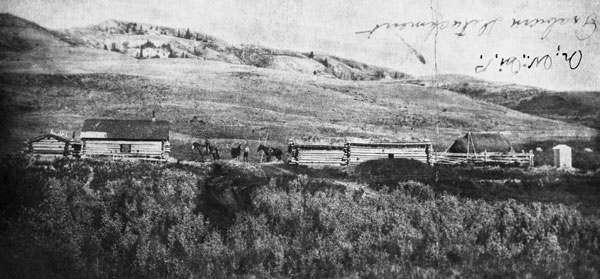
WHAT WE KNOW:
Marmaduke Graburn enlisted in the North West Mounted Police in Ottawa and was sworn in as a constable on June 9, 1879 in Fort Walsh, Northwest Territories. His regimental number was 335, and the new recruit was assigned to horse camp. On November 17, 1879, the 19-year-old became the first member of Canada’s national police force to be murdered while on duty. He is buried in Saskatchewan at Fort Walsh National Historic Site of Canada. His murder was never solved.
THE CONJECTURE:
More questions than answers. Horse camp was moved to fresh grass as required. It appears that documenting just where it was situated at the time of the murder was overlooked, but there was a garden between the fort and the camp. It seems Graburn forgot his axe and picket rope in the garden and rode back to retrieve them. He never returned.
Edward Butts’ book Line of Fire: Heroism, Tragedy and Canada’s Police claims the constable’s steed was gunned down so he wouldn’t make it to the camp or the fort to sound the alarm. Meanwhile in The Mounties; Tales of Adventure and Danger from the Early Days by author Elle Andra- Warner says the mount wandered into camp that evening still saddled and bridled. Many publications have the horse returning to camp, while in others he drifts into the fort. Two out of three scenarios are myth — which one is fact?
Most reports state that the legendary Jerry Potts led the search; often no one else is even mentioned. However, Butts names Constable R. McCutcheon as the man that found the remains. The book Early History of the Medicine Hat Country by J.W. Morrow says that Louis Leveille and his sons Paul and Gabe accompanied Potts in the search, and Louis discovered the deceased. Author Jim Wallace concurs that the senior Leveille found the body in his book A Double Duty.
The local history book From Sage to Timber, confirms Louis was a NWMP scout, guide and interpreter from the Trek West until his 1888 passing. The 1989 book states that the cairn in Alberta, supposedly where the tragedy occurred, is dead wrong. In countless visits and interviews, Gabe (1866-1959) was adamant that his father found the body in Saskatchewan. He also shared that his dad believed white men killed Graburn. Louis had seen tracks of three men riding abreast whereas Indians rode single file. Signs suggested they had mounted from the left side, Indians got on from the right, and hoof prints indicated that one rider had dropped behind just before the constable was shot in the back.
Perhaps Leveille’s observations went unheeded because there was a built-in suspect. His name was Star Child. The young man had been harassing people for food until Graburn banished him from horse camp that morning. After the gruesome discovery of the body, police learned he’d vamoosed across the Medicine Line.
Healy’s West: The Life and Times of John J. Healy by Gordon Tolton reveals that authorities offered Sheriff Healy a $500 bounty to convey the culprit to Canadian soil but the Montana lawman demanded more and it never happened. Several sources relate that nearly 18 months after the murder, Mounties got wind that the fugitive was staying with family on the Blood (Kainai) Reservation and he was arrested after a violent struggle. But findagrave.com says the dust-up and capture took place near Fort Walsh, a 250-kilometre difference.

The trial took place at Fort Macleod and he was acquitted. Morrow states Star Child died a few months later. Others report that two years after being exonerated he was caught stealing horses and was convicted. The sentence is uncertain — Butts says three years, Andra-Warner claims 14, and in the Dictionary of Canadian Biography S.W. Horrall states it was four with early parole. The government webpage collectionscanada.gc.ca says four with no mention of parole. Denny’s Trek: A Mountie’s Memoir of the Trek West author Cecil E. Denny seems out of line when he declares it was five years but Star Child “died before completing his term”, because it’s well documented that while residing in the hoosegow the inmate learned English and ironically, when released, became a NWMP scout. Accounts of the reformed horse thief’s scouting career vary but all end the same; tuberculosis claimed the 28-year-old rogue in December of 1889.
IN SUMMATION:
The mystery of the Graburn case may never be solved, but his name will live on. In 1888, the NWMP established an outpost named in his honour—Graburn Detachment—which also defined a whole region. From the Trans-Canada highway at Walsh, Alta., turn south on Graburn Road, follow the gravel route through the old Graburn School District, and eventually you’ll enter Cypress Hills Interprovincial Park where you can stay at Graburn Campground near Graburn Creek.
Over a century ago in our Nation’s Capital, NWMP members erected a memorial to their fallen comrade. Today those grounds are known as The RCMP National Memorial Cemetery and in part the inscription on the towering cenotaph reads, “Marmaduke Graburn — Primus Moriri (First to die).”















